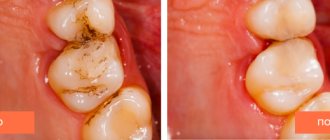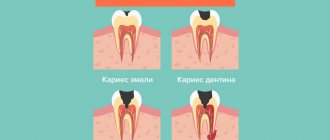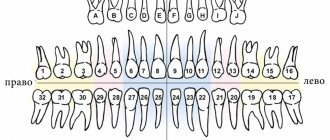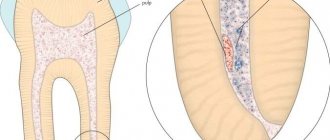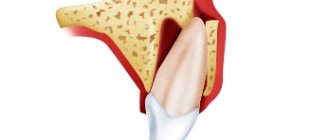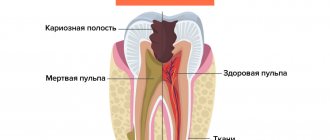Simultaneous instrumentation and permanent obturation of the root canals is performed in the absence of contraindications to filling. If there is pain, swelling, abscesses, exudate and an unpleasant odor, drug treatment must be carried out before closing the cavity. It includes exposing the treatment area to medications that eliminate existing problems and prepare the canals for the installation of a permanent filling.
Treatment of pulpitis and periodontitis in children by our experienced pediatric therapists:
- treatment with a smile, no stress for the child , no tears
- pediatric doctors become friends for young patients
- doctors save baby and permanent teeth
- more than 7,890 children who are happy to have their teeth treated with us
- While the child is getting his teeth treated, the parents go about their business
- quality treatment at prices in the residential area of Yasenevo
How is pulpitis treated?
Treatment of tooth pulpitis is aimed at preserving the unit, relieving symptoms, and preventing the development of purulent inflammation. The most commonly used method is depulpation, i.e. removal of the pulp along with the neurovascular bundle. However, after such a procedure (due to loss of innervation and blood supply), the tooth becomes “dead” and gradually collapses. Therefore, if the pulp is slightly damaged, biological methods of its treatment are used, aimed at maintaining the viability of the structure. If serious complications develop, the question of tooth extraction may arise.
Reviews about the clinic on independent portals:
Treatment methods for pulpitis
Elimination of pulp inflammation is possible in two ways: conservative and surgical. The choice of one or another technique depends on the shape and degree of pulp damage.
Conservative treatment method
Non-surgical treatment is possible in the initial stages if the patient consults a doctor at the first signs of the inflammatory process. The biological method is aimed at eliminating inflammation of the pulp and restoring its functionality. This method of treatment is acceptable if a number of conditions are met:
- patient age up to 30 - 35 years;
- absence of changes in periodontal tissues (confirmed by x-ray);
- no signs of periodontitis.
Conservative therapy involves the use of medications. Before applying a medicated bandage with calcium hydroxide, the segment is cleaned of tissue affected by caries. The paste may contain antibacterial agents, hormones, and vitamins. A temporary filling is placed on top of the treatment pad. Which, upon a second visit, is replaced with a permanent one (if the patient has no complaints).
Surgical method of treatment
If it is impossible to use conservative therapy, surgical intervention is resorted to. Invasive treatment can be carried out using different protocols:
- Vital pulpotomy. During the procedure, the coronal part of the pulp is removed. The root tissue remains viable.
- Vital pulpectomy – complete removal of pulp tissue.
- Devital extirpation. The method involves removing the pulp after it has been necrotized with special preparations based on arsenic or paraformaldehyde.
- Devital amputation. The technique is used for canal obstruction. First, the coronal pulp is devitalized and removed. The root zone is impregnated with a mummifying compound that prevents rotting.
Treatment with a smile, no stress for the child, no tears
Pulpitis of primary and permanent teeth in pediatric dentistry is quite common; approximately 90% of children with advanced caries suffer from symptoms of this disease. Children's pulpitis is accompanied by excruciating toothache, which deprives you of joy. The use of painkillers will not solve the problem, so the only correct solution is to visit a dentist. The Novodenta dental clinic offers the services of a pediatric dentist who will not only treat pulpitis or periodontitis, but will also find an approach to every little patient.
Medicines for the treatment of root canals in children
Today, pediatric dentists have a huge selection of medications for treating intracanal cavities at their disposal. The products most actively used by leading dental clinics in Moscow are represented by the following categories and types:
- antibiotics (Metronidazole, Gramicidin, Polymyxin M);
- bactericidal compounds (Chlorhexidine, Sodium hypochloride, iodine, Iodinol, Lugol's solution, hydrogen peroxide, 30% urea solution);
- anti-inflammatory (Dicamphen, Iodex, Camphorphen, Guaifen, Pulposeptin, Indextrol);
- calcium hydroxide (powder, solution or paste composition) and hydroxyapatites (Hydroxyapol, Kergap, Ostim-100);
- MTA preparations (mineral trioxide aggregate) – Biodentin, Restapex, Trioxident and others.
When choosing the optimal therapeutic drug, it is important not only to correctly assess the condition of the root canals and the general well-being of the patient, but also the nature of the problem. You should also take into account the quality of the substance used: biocompatibility, non-toxicity, moisture tolerance, hypoallergenicity, effectiveness, etc. Upon completion of medication treatment, it is imperative to re-examine the canals and perform their permanent obturation.
What is pulpitis
Pulpitis is an inflammation of the connective tissue that contains nerve endings, blood and lymphatic vessels. The pulp itself is located under a layer of dentin inside the tooth, consists of a cellular part, vascular and nerve bundles, the defeat of which causes severe and acute pain. In children, pulpitis occurs many times more often than in adults. The reason for this is the fact that baby teeth, like permanent teeth, have a thinner layer of enamel and dentin, which allows infection to quickly penetrate into the deep tissues of the tooth. The pulp is very important because it provides growth and nutrition to tooth tissue.
How to recognize pulpitis
Pulpitis can be diagnosed by the appearance of characteristic clinical signs:
- pain that gets worse at night;
- sharp reaction to stimuli;
- pain when chewing;
- darkening of the enamel;
- severe destruction of the crown walls;
- swelling of the mucous membrane around the segment;
- hypertrophied pulp tissues protrude above the chewing surface.
It is not always possible to recognize the disease on your own. If inflammation has developed under the filling, and the crown is slightly damaged or not damaged at all, then instrumental diagnostics are required.
Causes and symptoms of pulpitis in children
Inflammation of the pulp, according to pediatric dentists, can occur for several reasons, including:
- caries;
- acute infectious diseases that led to decreased immunity and inflammatory processes in the oral cavity;
- dental injuries.
Symptoms of pulpitis in children are manifested by the following signs:
- sharp and throbbing pain in the area of the diseased tooth;
- increased body temperature;
- swelling, redness of the gums;
- general weakness, fever;
- increased sensitivity of teeth.
The main symptom of the disease is throbbing pain, which can occur at any time of the day. If you do not pay attention to the problem, this can lead to complications in the form of purulent inflammation, periodontitis and other consequences.
Causes of occurrence and development of pulpitis
The main etiological factor that plays a role in the occurrence and development of pulpitis is untreated caries in a timely manner. Microbes living in a carious lesion penetrate into the pulp cavity, where they actively multiply and also produce toxic waste products that are destructive to the pulp fibers. In addition, pulpitis can occur due to the following reasons:
- retrograde penetration of infection into the pulp through the apical foramen during periodontitis;
- hematogenous spread of bacteria in the presence of chronic inflammatory foci in the body;
- iatrogenic damage to fibers during caries treatment (prolonged thermal exposure, overdrying, chemical burn, etc.);
- mechanical trauma to tissue (perforation of the cavity wall during drilling, dislocation of a segment, fracture of the crown, root), etc.
Classification
Pulpitis in children can affect both milk and permanent teeth and manifest itself in several forms - acute and chronic.
Acute pulpitis of milk teeth or permanent teeth is divided into several types:
- Focal - attacks of pain last up to 30 minutes, most often appear after consuming cold or hot food or drinks.
- Diffuse – the middle layer of the pulp is damaged, the pain can last for several hours, and intensifies in the evening.
- Purulent - inflammation affects not only the pulp, but also affects the gums. Upon examination, you may notice a discharge of grayish or yellow liquid.
If you do not pay attention to the problem, the acute form quickly turns into chronic, which also has several forms:
- Fibrous – inflammation affects the root canals, tooth enamel quickly turns black, there is a reaction to hot and cold food, pain is practically not a concern.
- Hypertrophic – a polyp forms in the tooth cavity, the gums bleed, and there is a putrid odor from the mouth.
- Gangrenous is a dangerous type of disease when the pulp completely dies, and healthy tissue begins to be damaged.
Regardless of the form and type of the disease, treatment of pulpitis in milk or permanent teeth should be carried out as quickly as possible, this will help to eliminate the development of complications.
Indications for medicinal effects on the canals
The main method of endodontic treatment is mechanical cleaning of the canals with constant rinsing. Moreover, in some cases, dentists use medicinal preparations of various effects. These include the following diseases:
- acute form of chronic, traumatic, toxic or infectious periodontitis;
- chronic development of periodontitis with a predominance of anaerobic microflora, periapical defect of bone tissue or constant canal humidity;
- the need for endodontic treatment at the stage of incomplete root formation or its apex;
- traumatic damage to permanent or temporary teeth;
- perforation of the root wall, external or internal resorption.
Treatment of periodontitis in baby teeth
Treatment of periodontitis in a baby tooth is aimed at removing the infection in the tooth and beyond, located in the ligament that holds the tooth. Most often, treatment of periodontitis of a baby tooth does not lead to successful preservation of the tooth, so a surgical treatment method is quite appropriate in this case.
Child's complaints. With periodontitis, complaints may include food getting stuck in the tooth, pain when biting on the tooth, constant pain that gets worse when biting, or there may be no complaints. It all depends on the degree of damage to the tooth.
What can parents see in their baby's mouth? A large cavity in the tooth, a severely damaged tooth, the absence of the crown part of the tooth, inflammation on the gums of a round shape of different sizes, colors, and sometimes diffuse inflammation of the gums. Purulent contents may also be released from the gums. The tooth may be mobile.
Treatment method. Conservative methods of treating periodontitis do not always achieve complete elimination of the source of infection, so there is a need for surgical intervention, ending with tooth extraction.
Recommendations. To avoid early tooth extraction and prevent dental anomalies, visit your dentist, but at least 3-4 times a year.
Treatment of permanent teeth
After changing the bite, the most common problems we encounter are caries and pulpitis. However, restoration work requires special care, especially if it concerns the frontal zone. It is important not only to treat the front tooth, restoring functionality, but also to preserve its aesthetics so that the child does not experience psychological discomfort when smiling.
To treat children's front teeth, we use photopolymer fillings with ultra-fine particles. They allow the doctor to create anatomically accurate restorations and ideally select the shade of the material.
Stages of treatment
The endodontic treatment program includes several stages:
- Introduction of anesthetic.
- Cleaning the carious cavity.
- Providing access to the pulp chamber using a drill.
- Removal of inflamed tissue along with the neurovascular bundle using one of the surgical methods.
- Antibacterial treatment of canals and their sealing with gutta-percha.
- Restoration of the crown part of the tooth with polymer materials.
During their work, doctors use modern optical technology, which helps to carry out all manipulations with maximum precision. The treatment is carried out using anesthesia, thanks to which the patient does not feel pain during the procedure.
Why is it better to contact Aesculapius
We have some of the best conditions for dental services in Moscow. The main thing for us is to satisfy all the needs of patients, so we always meet our clients and offer optimal solutions. In our clinic, you can inexpensively treat pulpitis of temporary teeth in one visit or receive step-by-step pulp removal. By contacting us, you get a number of advantages:
- high quality standards;
- responsible approach to work;
- qualified specialists;
- guarantee for all services;
- affordable prices.
Service at our dental center is quick and comfortable. You will never see queues with us. There are four specialists working in the clinic at the same time: a therapist, a surgeon, an orthopedist, and a pediatric orthodontist. We offer reliable treatment for pulpitis of baby teeth in children using modern methods. You will not find such a favorable price-quality ratio anywhere else.
Call us any time. Our employees are always in touch and ready to provide all the necessary information about the treatment of caries in children. Don't miss this great chance to take care of your child's dental health inexpensively.
Price table for pulpitis treatment in Moscow
| Name of service | Cost of pulpitis treatment | Price |
| Mechanical and medicinal treatment of the canal + filling the canal with gutta-percha pins | 1-channel tooth | 4030 |
| 2 channel | 5800 | |
| treatment of 3-channel pulpitis | 8420 | |
| Treatment of the canal (fur and medicinal) + filling it with Thermofil, MTA | single channel | 4930 |
| two-channel | 7880 | |
| three-channel | 11200 | |
| Crown restoration with fluoropolymers | from 4600 | |
Where does treatment begin?
After you decide to enroll in Faceline dentistry, the child is examined by a doctor and diagnoses the problem. We use:
- targeted and panoramic photographs of teeth (X-ray doses are minimal);
- indicators of dental plaque (determine visually invisible boundaries of dental lesions);
- caries markers (reveal hidden carious cavities).
Then the dentist offers the parent ways to solve the problem and explains how much it costs to treat permanent or baby teeth. Together with the parent, we approve an action plan and get to work.

